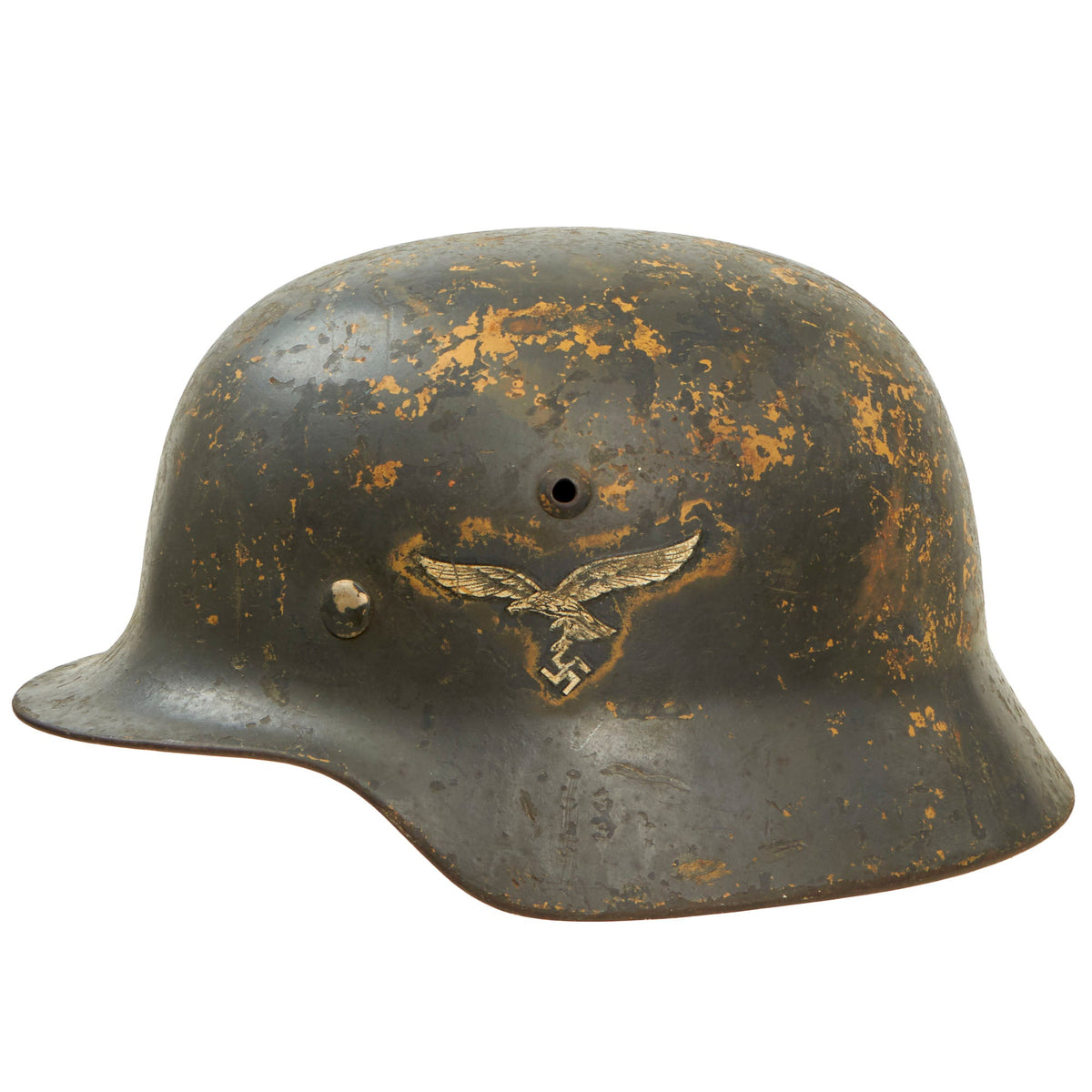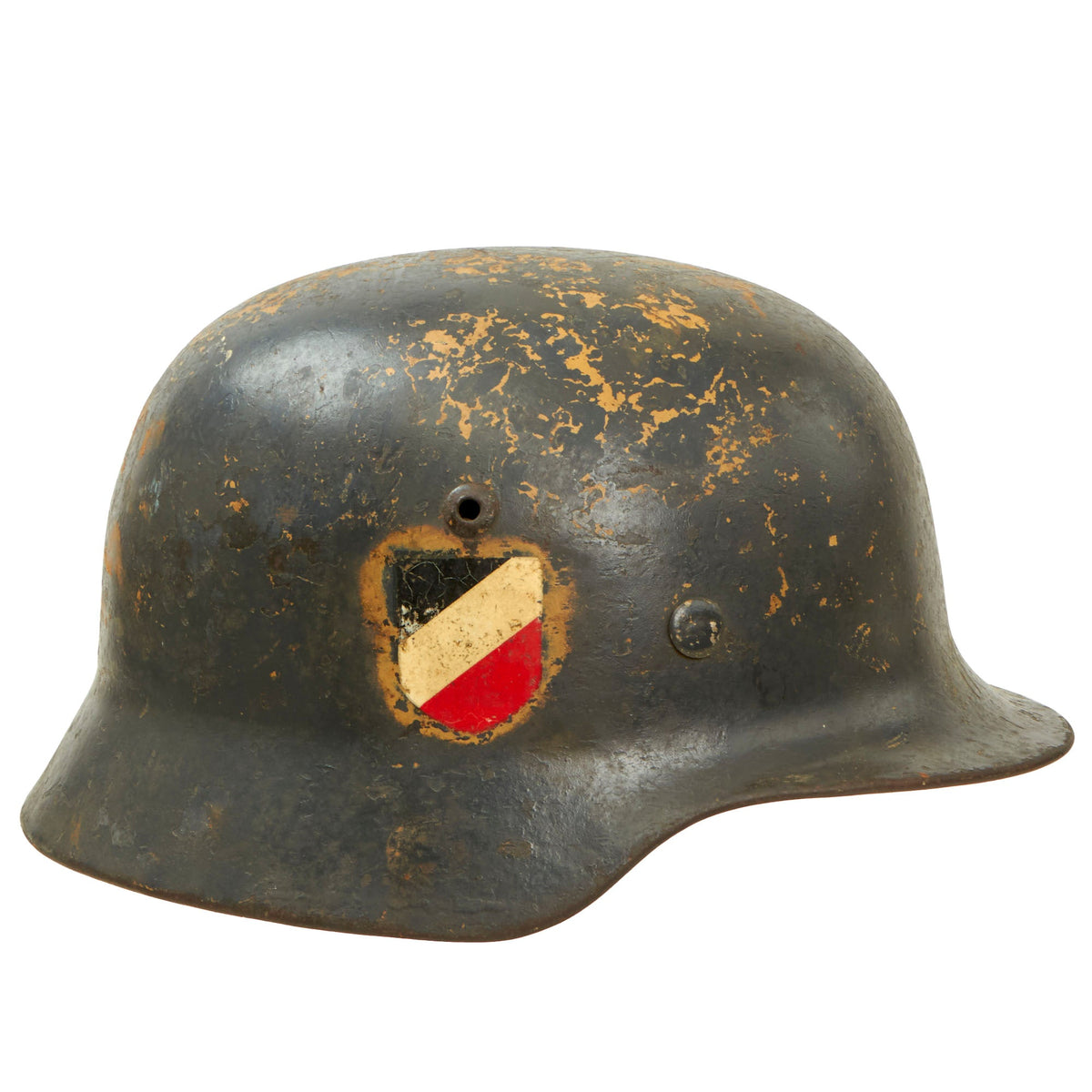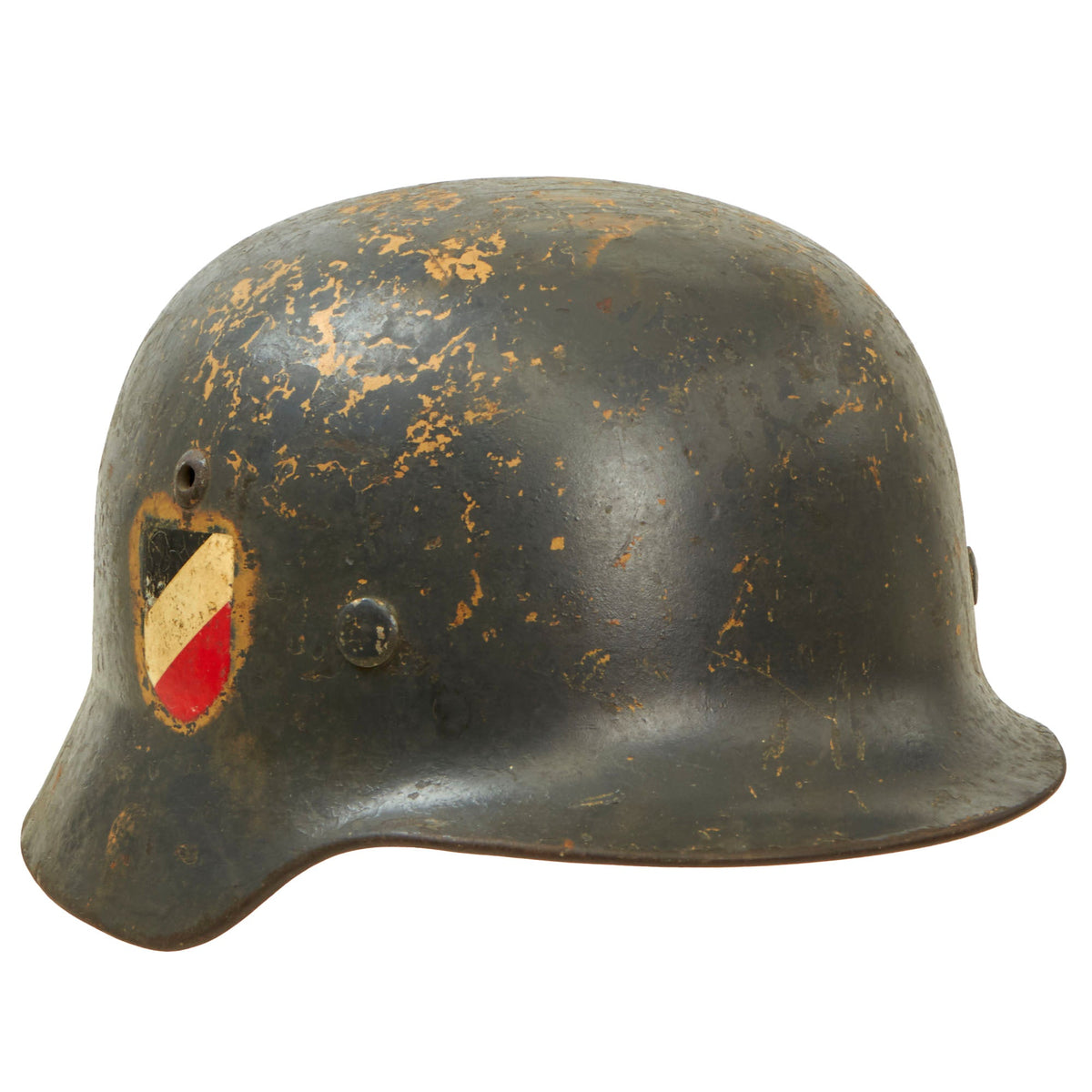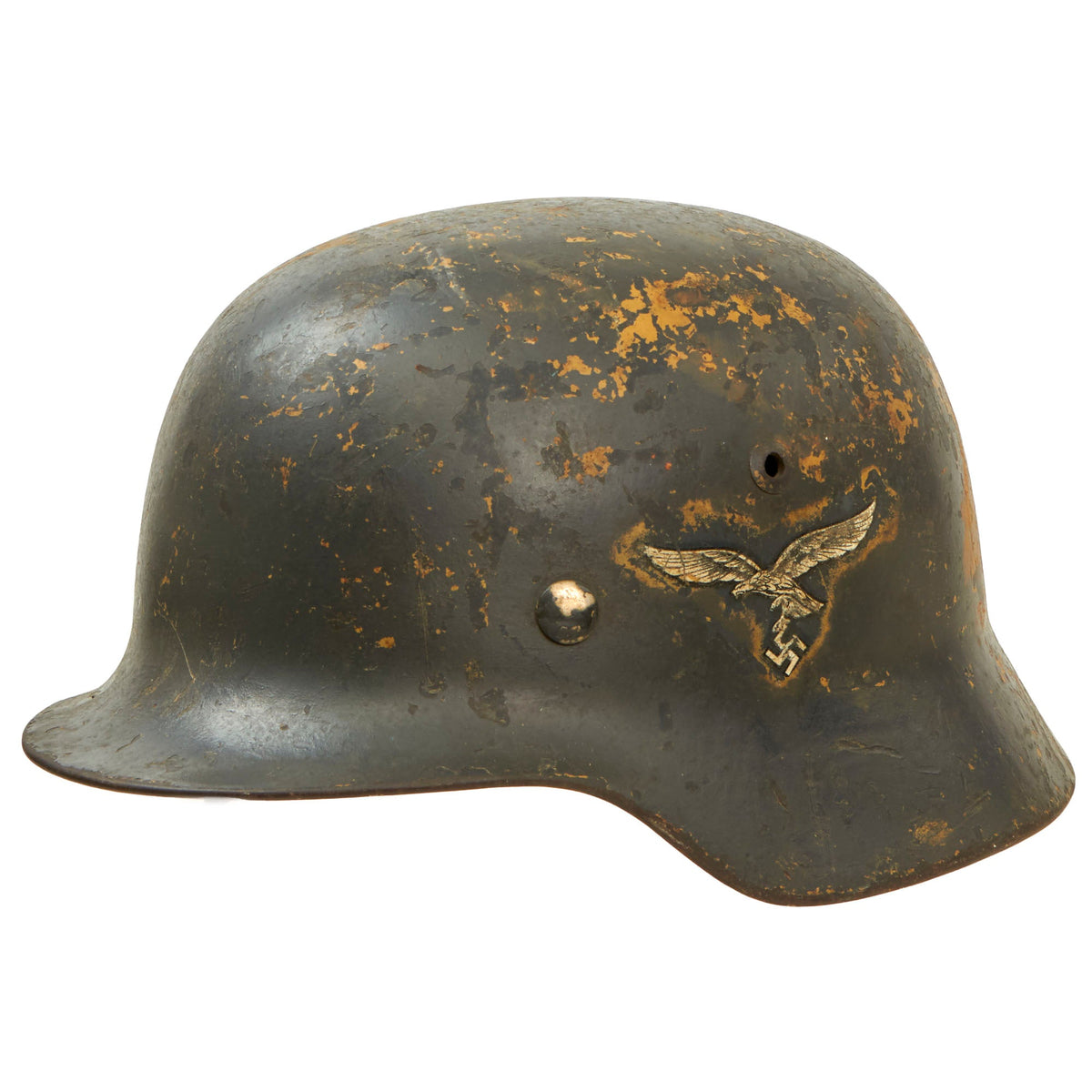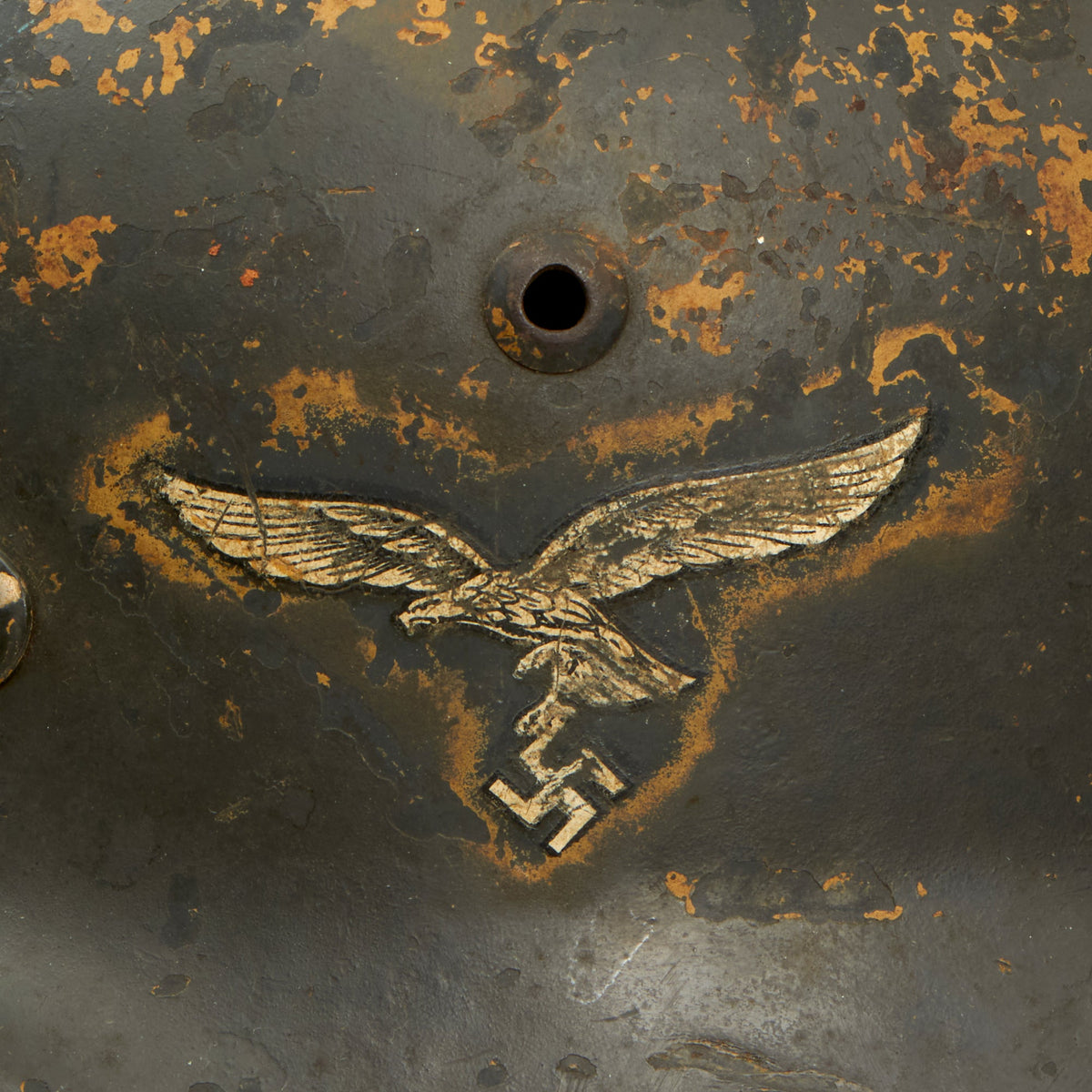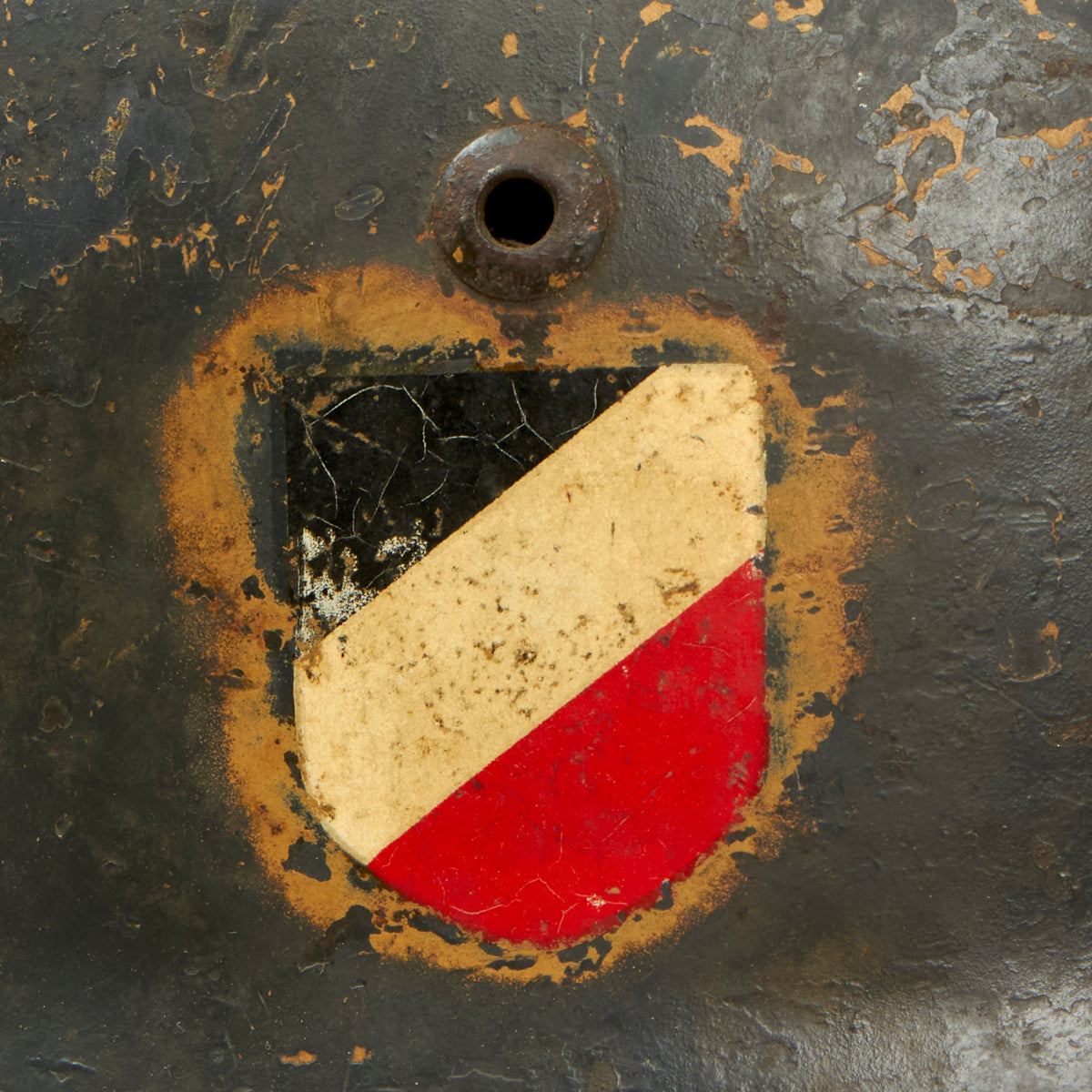Original German WWII Luftwaffe Named Double Decal Repainted Afrikakorps Tropical M35 Steel Helmet with 58cm Liner – SE66 Original Items
$ 2.395,00 $ 598,75
Original Item: Only One Available. This is the kind of helmet you very seldom see on the market, one that has really been there and back! This is a fantastic all original example Model 1935 German WWII “double decal” helmet with a Luftwaffe Eagle decal on the left side, and a “National Colors” decal on the right. The use of the second decal was discontinued in 1940, and in 1943 it was ordered that helmets with the national colors have them removed, so finding a helmet with both still intact is a real treat!
Even better than that however is that this helmet has THREE distinct layers of paint on it, which show the long history it has had during its time in service! It was originally painted the correct Fliegerblau (flyer’s blue) color used on Luftwaffe helmets, which is still retained very well on the interior of the helmet. However, the wearer was then deployed to a tropical era, most likely North Africa as part of the Deutsches Afrikakorps. It was repainted with the Dunkelgelb (Dark Yellow) tan color used in that campaign, however the paint was left off the decals. The owner then apparently returned to Europe, and the helmet was painted Fliegerblau again, over the DAK tan. The decals were again uncovered, and the repaint unfortunately did not adhere firmly to the tan.
The result is this fantastic helmet where all three layers of paint can be seen due to the subsequent wear the helmet received in service. This look is impossible to duplicate, and really makes this a fantastic example. It shows wear consistent with long service, but not abuse. The decals are also in great shape, with the National Colors decal retained at about 80%, showing checking due to age and some wear, and the Luftwaffe Eagle decal retained just a bit less, also showing checking and age. This helmet is really something!
The reverse, interior, neck guard apron is batch number stamped 4310, and the interior, left side, apron has a stamped manufacturer’s code and size, SE66. This indicates it was manufactured by Sächsische Emaillier und Stanzwerke A.G. of Lauter, Germany in size 66. This is a nice large size that can accommodate size 58cm and 59cm liners, or 7 1/4 – 7 3/8 US. Shells of this large size are harder to find, and more valuable to a collector. Even better, the inner left skirt is named to Flg. R. Ochsendorf, giving this helmet some great research potential! “Flieger” is an enlisted rank in the Luftwaffe equivalent to an USAAF Airman.
All three of the original liner split pins are present, however they have nickel alloy heads, which has caused much of the original paint to wear off on some. The interior of the helmet still has the original M31 leather liner with all eight of its fingers intact and an intact replaced top tie. The leather is still supple, but definitely shows that the helmet saw much service. It is stained overall, and shows wear on the top rim. The liner band is aluminum, with square aluminum chin strap loops attached to reinforced sides. This is the last pattern before the move to galvanized steel bands, as aluminum was scarce. The left exterior of the liner band is marked 66 n.A 58, indicating that it is a size 58 liner for a size 66 shell. The right side displays the full manufacture information, as well as a date:
B. & C.
BERLIN
1939
This liner was made by Biedermann & Czarnikow, a German company who later moved operations to Łódź in occupied Poland to take advantage of the slave labor in the ghetto located there. NSDAP authorities renamed Łódź to Litzmannstadt in honor of the German General Karl Litzmann who had captured the city in the previous World War. This is exactly the right period and type of liner for this very early helmet.
The left loop still has a partial longer section of the chinstrap installed, with the correct aluminum retaining stud. It still has 7 of the 13 adjustment holes present, with the end broken off. The leather is definitely a bit stiff, and in somewhat delicate condition.
Overall a fantastic totally correct 100% genuine double decal Luftwaffe helmet with an incredible history, having been to the tropical theater and returned! This helmet is ready to research and display! We do not get helmets like these very often at all.
The first “modern” steel helmets were introduced by the French army in early 1915 and were shortly followed by the British army later that year. With plans on the drawing board, experimental helmets in the field, (“Gaede” helmet), and some captured French and British helmets the German army began tests for their own steel helmet at the Kummersdorf Proving Grounds in November, and in the field in December 1915. An acceptable pattern was developed and approved and production began at Eisen-und Hüttenwerke, AG Thale/Harz, (Iron and Foundry Works), in the spring of 1916.
These first modern M16 helmets evolved into the M18 helmets by the end of WWI. The M16 and M18 helmets remained in usage through-out the Weimar Reichswehr, (National Defence Force, Circa 1919-1933), era and on into the early years of the Third Reich until the development of the smaller, lighter M35 style helmet in June 1935.
The Luftwaffe pattern national eagle was originally introduced for wear by Fliegerschaft, (Pilot Base), personnel of the DLV, Deutscher Luftsportsverband, (German Air Sports Association), the clandestine, civilian, forerunner of the Luftwaffe on August 18TH 1934, and adopted for wear by the Luftwaffe on March 1ST 1935 along with the national tri-color shield for wear on the helmet.
The first pattern national eagle was utilized until a modified second pattern eagle was introduced in late 1936 or early 1937. Regulations of June 12TH 1940 discontinued the use of the national tri-color decal and further regulations of August 28TH 1943 abolished the national eagle decal and dictated that it was also to be removed from all helmets although the directives were not completely adhered to.
Fast Shipping with Professional Packaging
Thanks to our longstanding association with UPS FedEx DHL, and other major international carriers, we are able to provide a range of shipping options. Our warehouse staff is expertly trained and will wrap your products according to our exact and precise specifications. Prior to shipping, your goods will be thoroughly examined and securely secured. We ship to thousands clients each day across multiple countries. This shows how we're dedicated to be the largest retailer on the internet. Warehouses and distribution centres can be located throughout Europe as well as the USA.
Note: Orders with more than one item will be assigned a processing date depending on the item.
Before shipping before shipping, we'll conduct a thorough inspection of the items you have ordered. Today, the majority of orders will be delivered within 48 hours. The delivery time will be between 3-7 days.
Returns
The stock is dynamic and we cannot completely manage it because multiple stakeholders are involved, including our factory and warehouse. So the actual stock may alter at any time. It's possible that you may not receive your order once the order has been made.
Our policy is valid for a period of 30 days. If you don't receive the product within 30 days, we are not able to issue a refund or an exchange.
You can only return an item if it is unused and in the same state as the day you received it. You must have the item in its original packaging.
Related products
Uncategorized
Uncategorized
Uncategorized
Uncategorized
Uncategorized
Uncategorized
Uncategorized
Band of Brothers ORIGINAL GERMAN WWII Le. F.H. 18 10.5cm ARTILLERY PIECE Original Items
Uncategorized
Armored Burgonet Helmet & Polearm from Scottish Castle Leith Hall Circa 1700 Original Items
Uncategorized
Uncategorized
Uncategorized
Uncategorized
Uncategorized
Uncategorized
Armoured Fighting Vehicles of the World: AFVs of World War One (Hardcover Book) New Made Items
Uncategorized
Uncategorized
